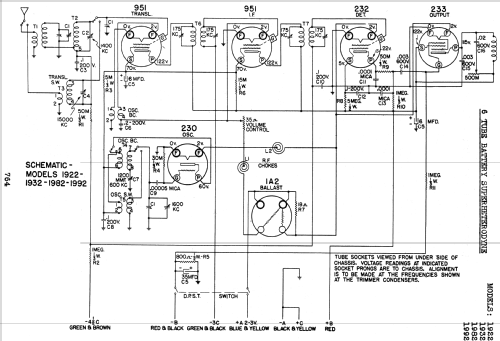Silvertone 1932
Sears, Roebuck & Co.; Chicago (IL)
- País
- Estados Unidos
- Fabricante / Marca
- Sears, Roebuck & Co.; Chicago (IL)
- Año
- 1935/1936
- Categoría
- Radio - o Sintonizador pasado WW2
- Radiomuseum.org ID
- 225755
-
- Brand: Silvertone
Haga clic en la miniatura esquemática para solicitarlo como documento gratuito.
- Numero de valvulas
- 5
- Principio principal
- Superheterodino en general; ZF/IF 175 kHz; 1 Etapas de AF
- Número de circuitos sintonía
- 6 Circuíto(s) AM
- Gama de ondas
- OM y OC
- Tensión de funcionamiento
- Baterías recargables o pilas / 2-3 & -3 & -4.5 & 3 x 45 Volt
- Altavoz
- Altavoz magnético (sin saber mas) / Ø 8 inch = 20.3 cm
- Material
- Madera
- de Radiomuseum.org
- Modelo: Silvertone 1932 - Sears, Roebuck & Co.; Chicago
- Forma
- Consola en general
- Anotaciones
-
The Sears Silvertone 1932 is a battery operated 5 tube BC and SW band receiver.
Band Frequency Ranges are as follows:
BC Band.............540-1600kHz
SW Band............5.9-16.0MHzChassis and schematic used in this model also used in models 1922, 1982 and 1992. These models are similar to Colonial Model 659 page 5-45.Changes:1)1A2 ballast tube instead of similar 30 ballast tube.2) IF peak 175KC instead of 480KC.3) 8 M.F.D. screen filter condenser instead of 6 M.F.D.
Uses Qty(3) 45 volt "B" batteries, Qty(1) 4.5 volt "C" battery tapped at -3 volts and Qty(1) 3 volt dry "A" battery. The ballast tube (1A2) maintains the filament voltage at 2 volts. If a 2 volt storage battery is used for the "A" supply, the ballast tube should be replaced with a 4 prong plug having its grid and plate prongs and the filament prong opposite the plate prong all connected together.
See details and summaries about Sears catalogs etc. This model was manufactured for Sears by Colonial Radio Corp., Buffalo, NY (Sears Manufacturer Source Number Code 101).
- Ext. procedencia de los datos
- Ernst Erb
- Referencia esquema
- Rider's Perpetual, Volume 7 = 1936 and before
- Mencionado en
- Machine Age to Jet Age II (page 259.)
- Documentación / Esquemas (1)
- Riders : Colonial 5-45, 46 ; Sears 7-69
- Documentación / Esquemas (4)
- Silvertone Radios, Service Inf. 1928 thru 1936 (Pages 764 to 768)
- Autor
- Modelo creado por John Kusching. Ver en "Modificar Ficha" los participantes posteriores.
- Otros modelos
-
Donde encontrará 5527 modelos, 3234 con imágenes y 4235 con esquemas.
Ir al listado general de Sears, Roebuck & Co.; Chicago (IL)





